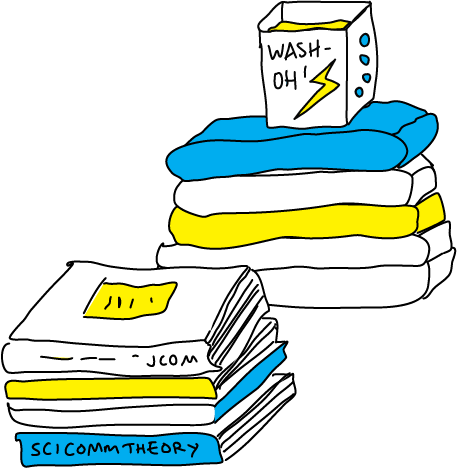References
References used in this project include the following:
Jo's PhD Zotero library is also online
A
American Association for the Advancement of Science (AAAS). (n.d.). Communicating to Engage. Retrieved 15 October 2018, from aaas.org/resources/communication-toolkit
B
Bailey, J., Salmon, R., & Horst, M. (2022). The ‘Engagement Incubator’: Using design to stimulate reflexivity about public engagement with science. Journal of Science Communication, 21(04), A01. doi.org/10.22323/2.21040201
Blue, G. (2019). Science Communication Is Culture: Foregrounding Ritual in the Public Communication of Science. Science Communication, 41(2), 243–253. doi.org/10.1177/1075547018816456
Bowater, L., & Yeoman, K. (2013). Science communication: A practical guide for scientists. Wiley.
Bucchi, M., & Trench, B. (2014). Routledge Handbook of Public Communication of Science and Technology: Second edition. Routledge. doi.org/10.4324/9780203483794
C
Canfield, K., & Menezes, S. (2020). The State of Inclusive Science Communication: A Landscape Study. Metcalf Institute, University of Rhode Island. informalscience.org/state-inclusive-science-communication-landscape-study
Cormick, C. (2020). Top tips for getting your science out there. Nature. doi.org/10.1038/d41586-020-00239-6
Cross, N. (1982). Designerly ways of knowing. Design Studies, 3(4), 221–227. doi.org/10.1016/0142-694X(82)90040-0
Cunliffe, A. L. (2016). “On Becoming a Critically Reflexive Practitioner” Redux: What Does It Mean to Be Reflexive? Journal of Management Education, 40(6), 740–746. doi.org/10.1177/1052562916668919
Choi, B. C. K., & Pak, A. W. P. (2006). Multidisciplinarity, interdisciplinarity and transdisciplinarity in health research, services, education and policy: 1. Definitions, objectives, and evidence of effectiveness. Clinical & Investigative Medicine, 29(6), 351–364.
D
Davies, S. R. (2013). Constituting Public Engagement: Meanings and Genealogies of PEST in Two U.K. Studies. Science Communication, 35(6), 687–707.doi.org/10.1177/1075547013478203
Davies, S. R., & Horst, M. (2016). Science communication: Culture, identity and citizenship. Palgrave Macmillan.
Davies, S. R., & Felt, U. (Eds.). (2020). Exploring science communication. SAGE Publications.
Dawson, E. (2019). Equity, Exclusion and Everyday Science Learning: The Experiences of Minoritised Groups (1st edition). Routledge.
G
Gaver, W., Boucher, A., Pennington, S., & Walker, B. (2004). Cultural Probes and the Value of Uncertainty. Interactions, 11(5), 53–56. doi.org/10.1145/1015530.1015555
Guterman, N. B. (2002). The role of research in defining a ‘practiceable’ problem for social work: The parallax of community and family violence exposure among children and youths. Social Work Education, 21(3), 313–322. doi.org/10.1080/02615470220136894
H
Hächler, B. (2015). Museums as Spaces of the Present: The Case for Social Scenography. In N. Hoskin (Trans.), The International Handbooks of Museum Studies (pp. 349–369). Wiley. doi.org/10.1002/9781118829059.wbihms316
Horst, M. (2008). In Search of Dialogue: Staging Science Communication in Consensus Conferences. In D. Cheng, M. Claessens, T. Gascoigne, J. Metcalfe, B. Schiele, & S. Shi (Eds.), Communicating Science in Social Contexts: New models, new practices (pp. 259–274). Springer Netherlands. doi.org/10.1007/978-1-4020-8598-7_15
Horst, M. (2011). Taking Our Own Medicine: On an Experiment in Science Communication. Science and Engineering Ethics, 17(4), 801–815. doi.org/10.1007/s11948-011-9306-y
Horst, M. (2013). A Field of Expertise, the Organization, or Science Itself? Scientists’ Perception of Representing Research in Public Communication. Science Communication, 35(6). doi.org/10.1177/1075547013487513
Horst, M., Davies, S. R., & Irwin, A. (2017). Reframing Science Communication. In The Handbook of Science and Technology Studies (Fourth Edition, pp. 881–907). The MIT Press.
I
Irwin, A. (2014). Risk, science and public communication: Third-order thinking about scientific culture. In Routledge Handbook of Public Communication of Science and Technology: Second edition (pp. 160–172). Routledge. doi.org/10.4324/9780203483794
N
Nisbet, M. C., & Markowitz, E. (2015). Public Engagement Research and Major Approaches [Commissioned annotated bibliography]. Leshner Leadership Institute, American Association for the Advancement of Science. aaas.org/sites/default/files/content_files/Biblio_PublicEngagement_FINAL11.25.15.pdf
O
Opai, K. (2022, August 6). Pepeha for non-Māori. E-Tangata. e-tangata.co.nz/reflections/pepeha-for-non-maori/
P
Palmer, S. E., & Schibeci, R. A. (2014). What conceptions of science communication are espoused by science research funding bodies? Public Understanding of Science, 23(5), 511–527. doi.org/10.1177/0963662512455295
Parliamentary Office of Science and Technology (UK). (2006, March). Debating science. POSTnote, Number 260.parliament.uk/globalassets/documents/post/postpn260.pdf
R
Riedlinger, M., Broks, P., Massarani, L., Leach, J., Lewenstein, B. V., Schiele, B., & Gascoigne, T. (2020). Communicating Science: A Global Perspective. ANU Press. doi.org/10.22459/CS.2020
S
Salmon, R. A., & Roop, H. A. (2019). Bridging the gap between science communication practice and theory: Reflecting on a decade of practitioner experience using polar outreach case studies to develop a new framework for public engagement design. Polar Record, 1–14. doi.org/10.1017/S0032247418000608 Download file
Salmon, R. A., Priestley, R. K., & Goven, J. (2017). The reflexive scientist: An approach to transforming public engagement. Journal of Environmental Studies and Sciences, 7(1), 53–68. doi.org/10.1007/s13412-015-0274-4
Stocklmayer, S. (2013). Engagement with Science: Models of Science Communication. In Communication and engagement with science and technology: Issues and dilemmas: A reader in science communication (pp. 19–38). Routledge, Taylor & Francis Group.
Swire-Thompson, B., Miklaucic, N., Wihbey, J. P., Lazer, D., & DeGutis, J. (2022). The backfire effect after correcting misinformation is strongly associated with reliability. Journal of Experimental Psychology: General, 151, 1655–1665. doi.org/10.1037/xge0001131
T
Trench, B. (2008). Towards an Analytical Framework of Science Communication Models. In Communicating Science in Social Contexts (pp. 119–135). Springer, Dordrecht. doi.org/10.1007/978-1-4020-8598-7_7
This article was written about the process that informed this website:
Bailey, J., Salmon, R., & Horst, M. (2022). The ‘Engagement Incubator’: Using design to stimulate reflexivity about public engagement with science. Journal of Science Communication, 21(04), A01. doi.org/10.22323/2.21040201
